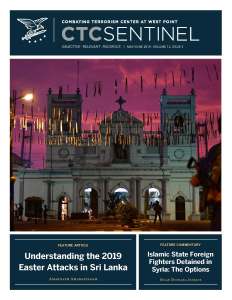From the Editor
The Easter Sunday attacks in Sri Lanka took the terrorism studies community by surprise because there had been no known history of jihadi violence inside the country and very little to indicate that local groups had the wherewithal to carry out such a large-scale coordinated operation. There is much that remains unclear about the links between the Sri Lankan cell and the Islamic State, but nearly 18 years after 9/11, the suicide bombings were a reminder that clandestine terrorist groups can, at any moment, strike in unexpected places and ways. In our cover article, Amarnath Amarasingam, whose research has focused on both Sri Lanka and global terrorism, outlines what is known about the network that carried out the Easter attacks and situates the attacks in the broader context of evolving intercommunal tensions in the country.
Brian Michael Jenkins examines the options for dealing with the significant numbers of Islamic State foreign fighters currently detained in Syria, warning that “endless delay” risks creating a serious threat to international security. Our interview is with Vidhya Ramalingam, the co-founder of Moonshot CVE, a company using technology to disrupt and counter violent extremism globally. Mitchell Silber examines how the terrorist threat against Jews in the West has evolved by examining attacks between 2012 and the present day. He notes that “what may be the most striking findings from this case study analysis are that first, Europe has become the focal point of the jihadi terror threat to Jews in the West and second, the United States has become a new, emerging focal point of the extreme right-wing terror threat to Jews in the West.” Last month, Abu Bakr al-Baghdadi appeared for the first time on camera since the Islamic State heralded its ‘caliphate’ in Mosul’s al-Nuri mosque five years ago. Haroro Ingram, Craig Whiteside, and Charlie Winter explain how the video underlined the group’s strategic transformation with the Islamic State’s leader now portraying himself as “the guerrilla ‘caliph’ of a global insurgency.”
Paul Cruickshank, Editor in Chief
 Skip to content
Skip to content

